1. Maximal Square
题目要求:
Given a 2D binary matrix filled with 0's and 1's, find the largest square containing all 1's and return its area.
For example, given the following matrix:
1 0 1 0 0 1 0 1 1 1 1 1 1 1 1 1 0 0 1 0
Return 4.
在GeeksforGeeks有一个解决该问题的方法:
1) Construct a sum matrix S[R][C] for the given M[R][C].
a) Copy first row and first columns as it is from M[][] to S[][]
b) For other entries, use following expressions to construct S[][]
If M[i][j] is 1 then
S[i][j] = min(S[i][j-1], S[i-1][j], S[i-1][j-1]) + 1
Else /*If M[i][j] is 0*/
S[i][j] = 0
2) Find the maximum entry in S[R][C]
3) Using the value and coordinates of maximum entry in S[i], print
sub-matrix of M[][]
构造完‘和矩阵S’后,我们只需求得该矩阵的最大值就可以了。
为什么只需求得该最大值就可以了?而且相同的最大值可能有很多个。细想下式我们就会知道‘和矩阵S’中的每一个值表示的都是从其他节点(本结点左上)到本节点所能构成的最大正方形的边长长度。
S[i][j] = min(S[i][j-1], S[i-1][j], S[i-1][j-1]) + 1
具体的程序如下:

1 class Solution { 2 public: 3 int min(const int a, const int b, const int c) 4 { 5 int minVal = (a < b)?a:b; 6 return (minVal < c)?minVal:c; 7 } 8 9 int maximalSquare(vector<vector<char>>& matrix) { 10 int rows = matrix.size(); 11 if(rows == 0) 12 return 0; 13 14 int cols = matrix[0].size(); 15 if(cols == 0) 16 return 0; 17 18 int maxEdge = 0; 19 vector<vector<int> > sum(rows, vector<int>(cols, 0)); 20 for(int i = 0; i < rows; i++) 21 { 22 if(matrix[i][0] == '1') 23 { 24 sum[i][0] = 1; 25 maxEdge = 1; 26 } 27 } 28 29 for(int j = 0; j < cols; j++) 30 { 31 if(matrix[0][j] == '1') 32 { 33 sum[0][j] = 1; 34 maxEdge = 1; 35 } 36 } 37 38 for(int i = 1; i < rows; i++) 39 for(int j = 1; j < cols; j++) 40 { 41 if(matrix[i][j] == '0') 42 sum[i][j] = 0; 43 else 44 sum[i][j] = min(sum[i-1][j-1], sum[i-1][j], sum[i][j-1]) + 1; 45 46 if(maxEdge < sum[i][j]) 47 maxEdge = sum[i][j]; 48 } 49 50 return maxEdge * maxEdge; 51 } 52 };
2. Largest Rectangle in Histogram
题目要求:
Given n non-negative integers representing the histogram's bar height where the width of each bar is 1, find the area of largest rectangle in the histogram.

Above is a histogram where width of each bar is 1, given height = [2,1,5,6,2,3].

The largest rectangle is shown in the shaded area, which has area = 10 unit.
For example,
Given height = [2,1,5,6,2,3],
return 10.
这道题目实际上跟动态规划没有什么关系,之所以将其放在这里是因为其跟下一道题关系很大。该题解法参考自一博文,程序如下:

1 class Solution { 2 public: 3 int largestRectangleArea(vector<int>& height) { 4 vector<int> s; 5 6 int sz = height.size(); 7 height.resize(++sz); 8 9 int maxArea = 0; 10 int i = 0; 11 while(i < sz) 12 { 13 if(s.empty() || height[i] >= height[s.back()]) 14 { 15 s.push_back(i); 16 i++; 17 } 18 else 19 { 20 int t = s.back(); 21 s.pop_back(); 22 maxArea = max(maxArea, height[t] * (s.empty() ? i : i - s.back() - 1)); 23 } 24 } 25 26 return maxArea; 27 } 28 };
该博文还照题目要求中的例子[2,1,5,6,2,3]解析了这个函数:
首先,如果栈是空的,那么索引i入栈。那么第一个i=0就进去吧。注意栈内保存的是索引,不是高度。然后i++。
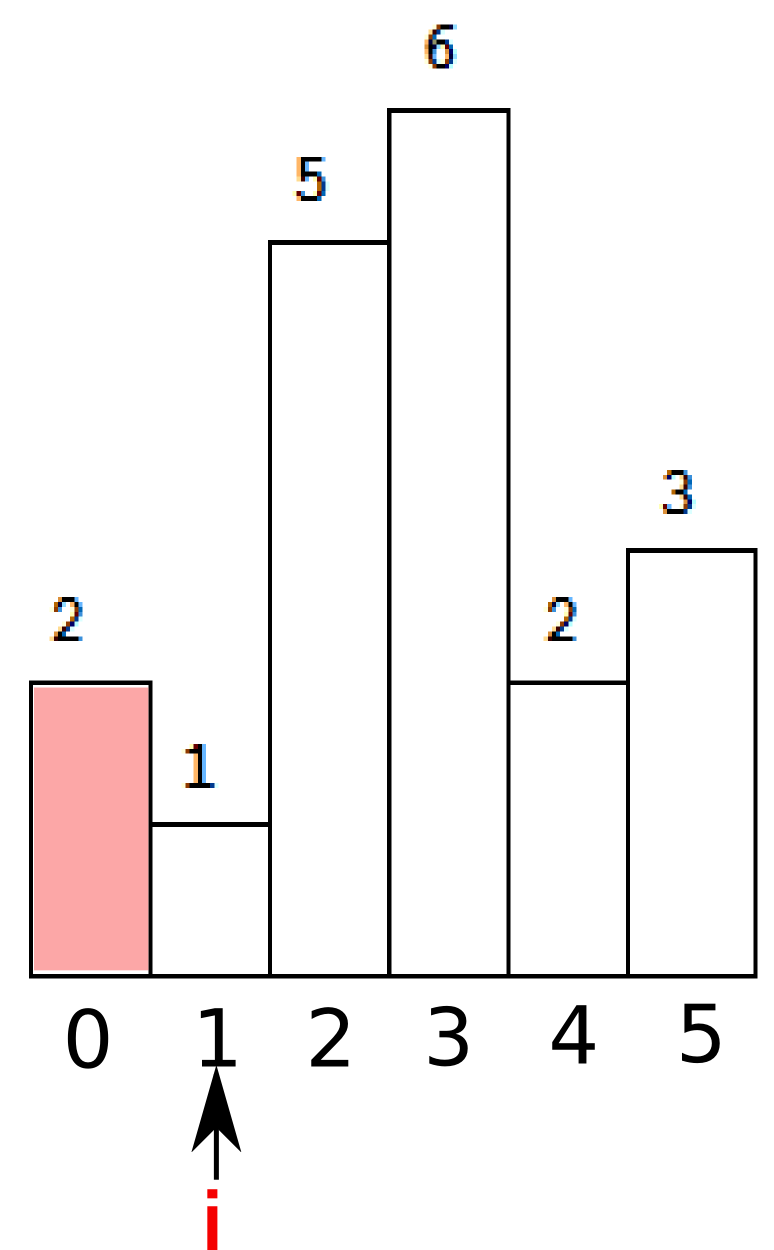
然后继续,当i=1的时候,发现h[i]小于了栈内的元素,于是出栈。(由此可以想到,哦,看来stack里面只存放单调递增的索引)
这时候stack为空,所以面积的计算是h[t] * i.t是刚刚弹出的stack顶元素。也就是蓝色部分的面积。
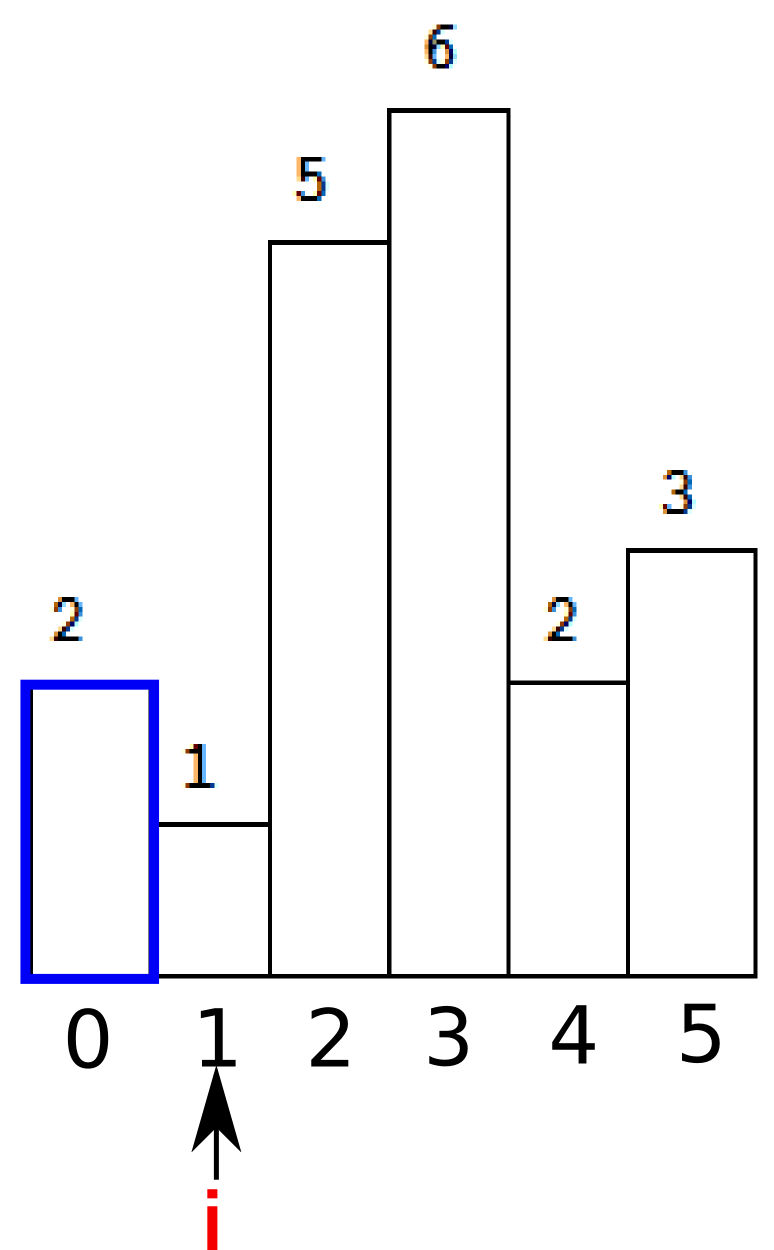
继续。这时候stack为空了,继续入栈。注意到只要是连续递增的序列,我们都要keep pushing,直到我们遇到了i=4,h[i]=2小于了栈顶的元素。
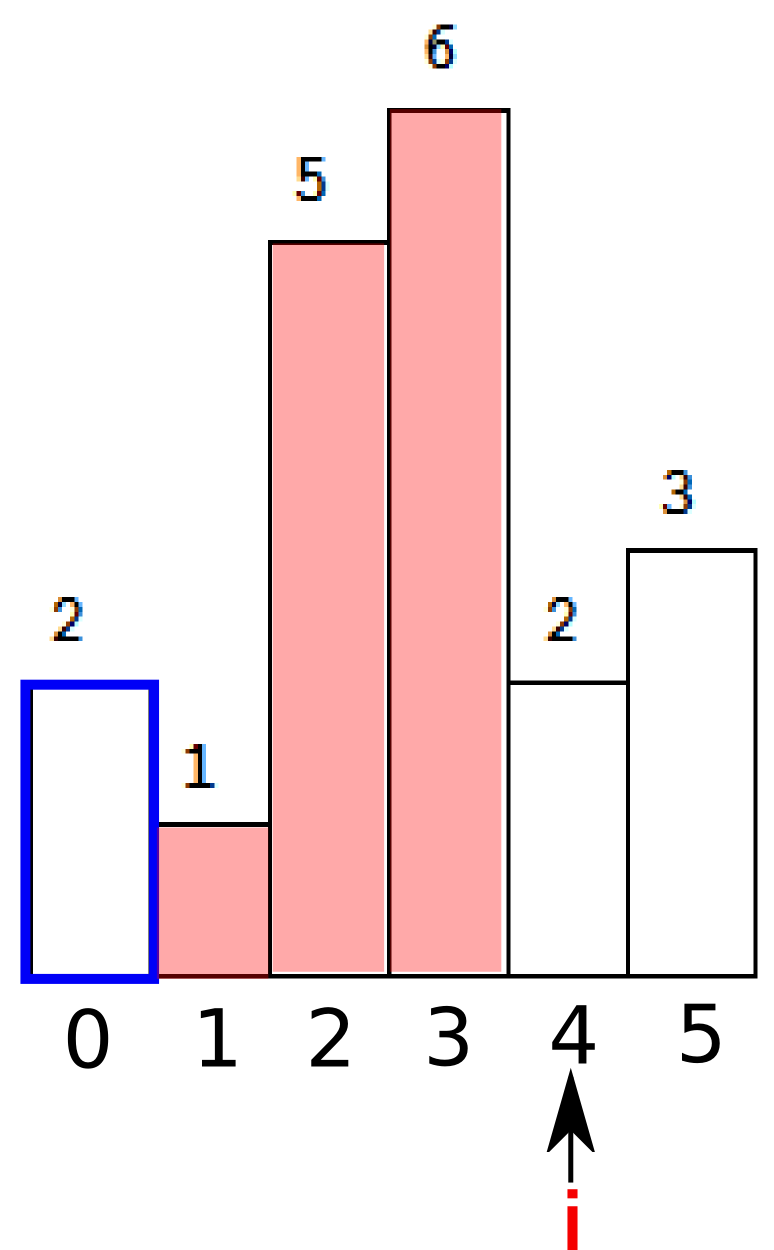
这时候开始计算矩形面积。首先弹出栈顶元素,t=3。即下图绿色部分。
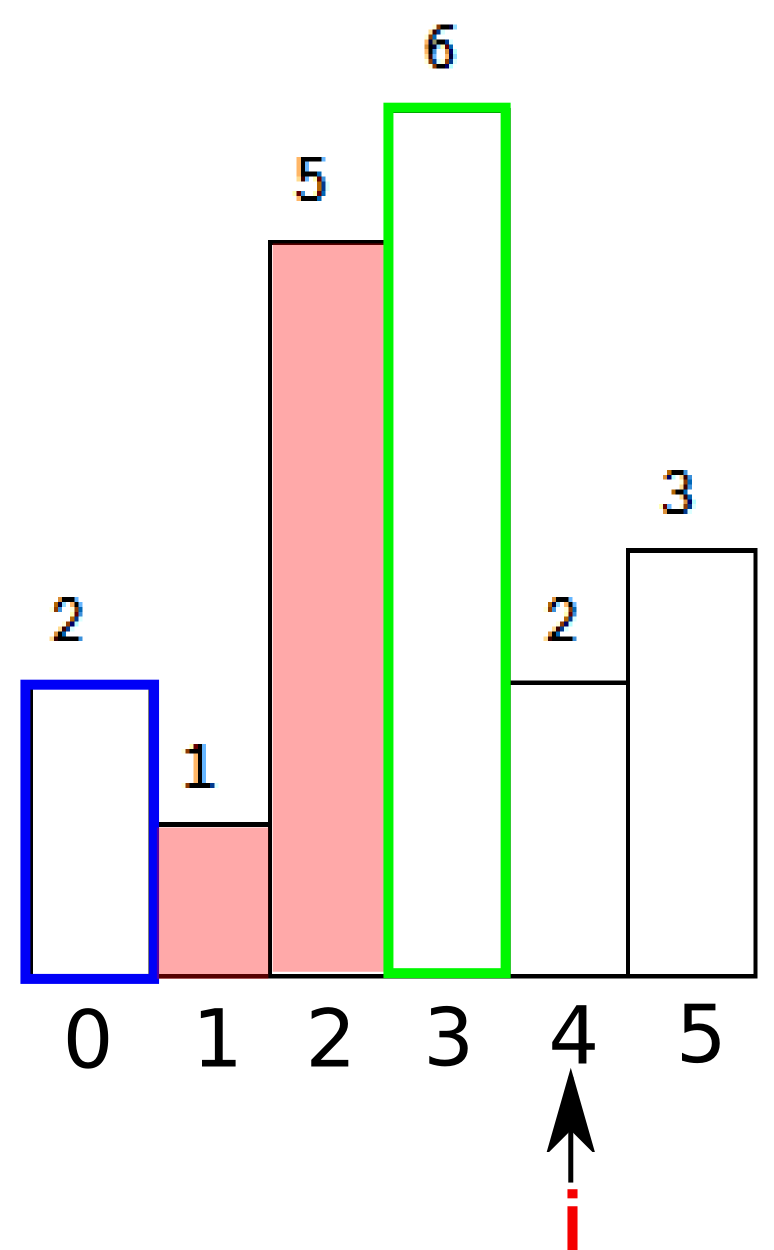
接下来注意到栈顶的(索引指向的)元素还是大于当前i指向的元素,于是出栈,并继续计算面积,桃红色部分。
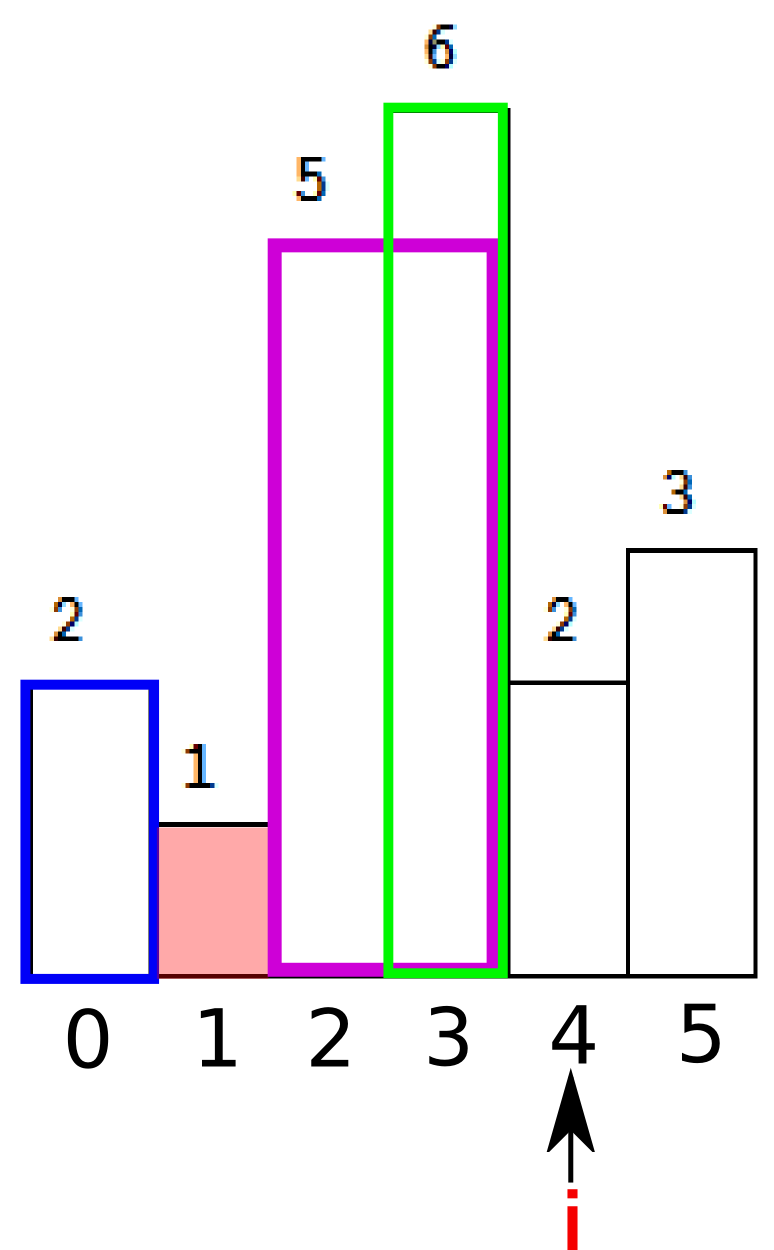
最后,栈顶的(索引指向的)元素大于了当前i指向的元素,循环继续,入栈并推动i前进。直到我们再次遇到下降的元素,也就是我们最后人为添加的dummy元素0.
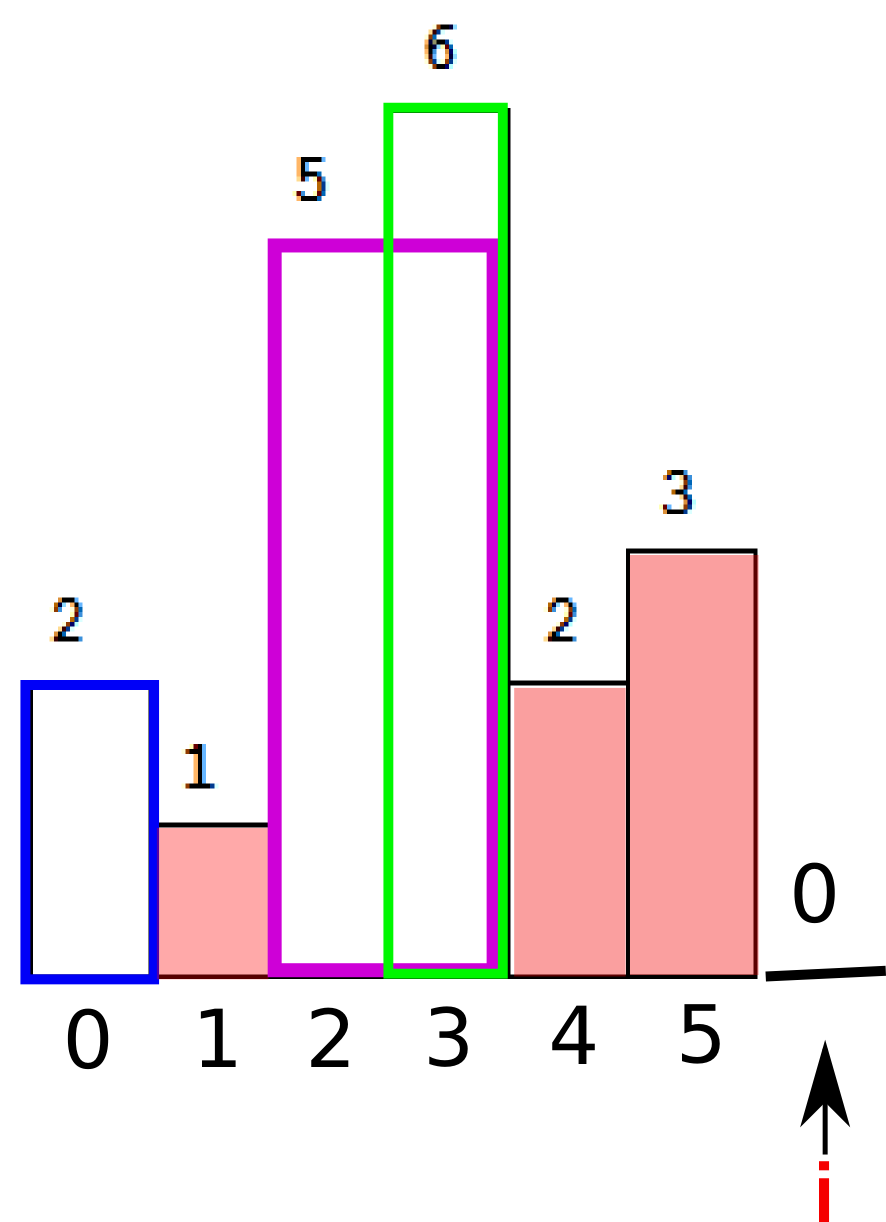
同理,我们计算栈内的面积。由于当前i是最小元素,所以所有的栈内元素都要被弹出并参与面积计算。
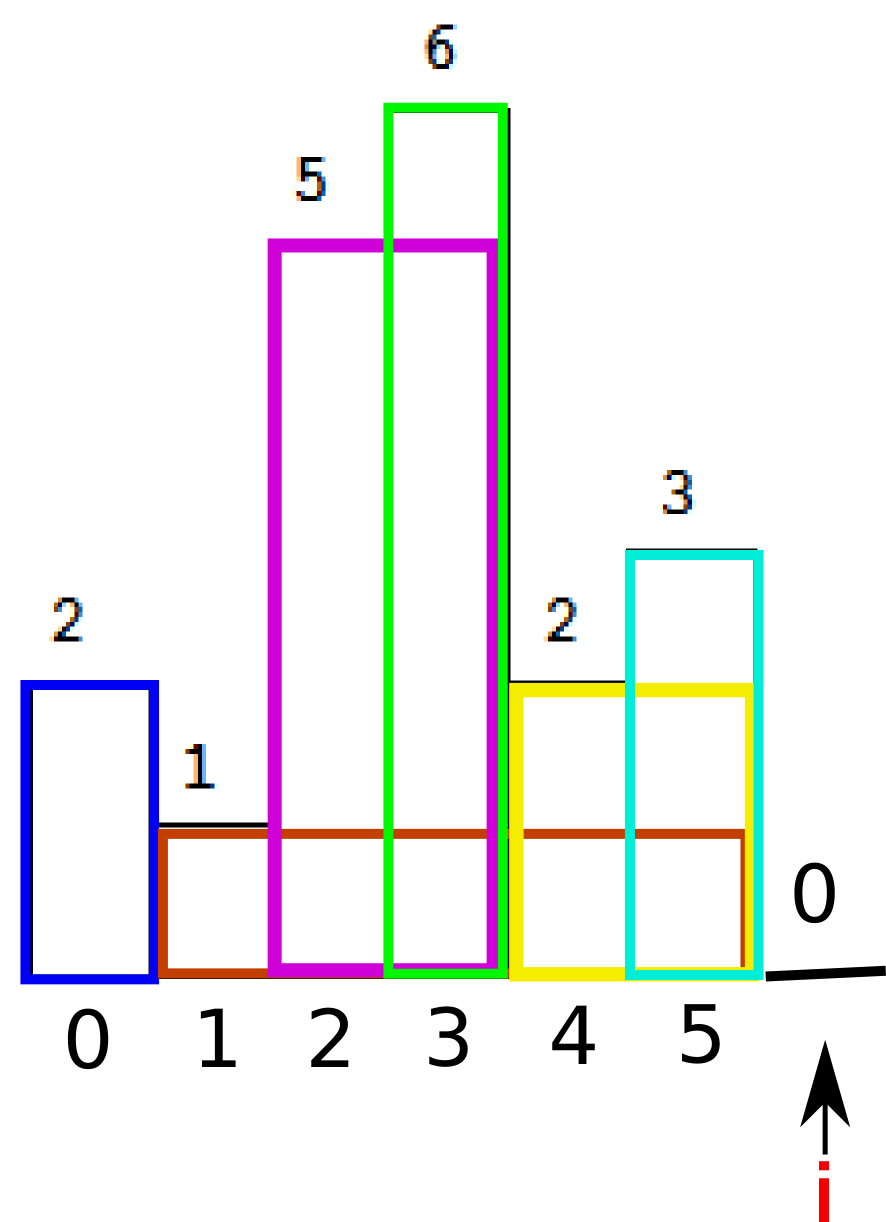
注意我们在计算面积的时候已经更新过了maxArea。
总结下,我们可以看到,stack中总是保持递增的元素的索引,然后当遇到较小的元素后,依次出栈并计算栈中bar能围成的面积,直到栈中元素小于当前元素。
3. Maximal Rectangle
题目要求:
Given a 2D binary matrix filled with 0's and 1's, find the largest rectangle containing all ones and return its area.
这道题的解决方法可以借鉴上题求直方图最大面积的方法,即我们把每一列当作直方图的每一列,输入则是每一列连续的‘1’的个数,具体程序如下:

1 class Solution { 2 public: 3 int largestRectangleArea(vector<int>& height) { 4 vector<int> s; 5 6 int sz = height.size(); 7 height.resize(++sz); 8 9 int maxArea = 0; 10 int i = 0; 11 while(i < sz) 12 { 13 if(s.empty() || height[i] >= height[s.back()]) 14 { 15 s.push_back(i); 16 i++; 17 } 18 else 19 { 20 int t = s.back(); 21 s.pop_back(); 22 maxArea = max(maxArea, height[t] * (s.empty() ? i : i - s.back() - 1)); 23 } 24 } 25 26 return maxArea; 27 } 28 29 int maximalRectangle(vector<vector<char>>& matrix) { 30 int rows = matrix.size(); 31 if(rows == 0) 32 return 0; 33 int cols = matrix[0].size(); 34 35 vector<vector<int> > height(rows, vector<int>(cols, 0)); 36 for(int i = 0; i < rows; i++) 37 for(int j = 0; j < cols; j++) 38 { 39 if(matrix[i][j] != '0') 40 height[i][j] = (i == 0) ? 1 : height[i-1][j] + 1; 41 } 42 43 int maxArea = 0; 44 for(int i = 0; i < rows; i++) 45 maxArea = max(maxArea, largestRectangleArea(height[i])); 46 47 return maxArea; 48 } 49 };
